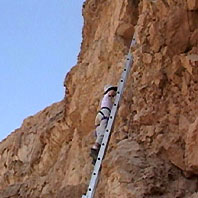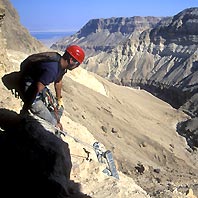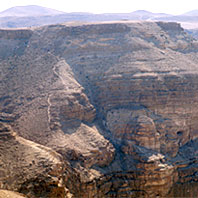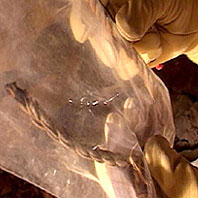|
In the summer of 2000, I was invited to visit the Cave of Letters during the
filming of "Ancient Refuge in the Holy Land." As executive producer of NOVA, I
don't get to go out in the field on shoots all that often, because I just don't
have time. But I love the excitement of being on location—directing,
being with the talent, seeing the story take shape before your eyes.
I won't say it was a slow period at NOVA, because there aren't really any slow
periods, but it seemed manageable, so I decided to go. What really lured me was
the idea of visiting one of the Dead Sea Scroll caves and seeing a place so
full of history, where the possibility of deepening our understanding of that
history through archeology was so real. For we were filming an archeological
expedition to the cave led by Dr. Richard Freund, a scholar, rabbi, and
professor at the University of Hartford.
I have to say that when I made the decision to go, I didn't comprehend how
inaccessible this cave is. We were at the NOVA press tour in Los Angeles, and
Kirk Wolfinger, the program's director, was there working with us on another
production. He had returned from Israel where he had been shooting in a cave,
and he said to me, "Don't worry, you'll be okay. It'll be fine." I said, "What
do you mean 'okay'? What do you mean, 'fine'?" I guess I thought I was going to
step out of my tent in the desert and walk over to the cave. Such, alas, was
not to be the case.
 The arrival
The arrival

When I arrived in Israel, I was driven to a kind of kibbutz in the desert near the Dead Sea. It was a very long ride, and we went in and out of the Green Line, the armistice boundary drawn between Israel and its Arab neighbors after the 1948 War of Independence. I've been to Israel many times before, and it was exhilarating to be back, especially since the team I was joining was full of interesting people. In addition to Dr. Freund, there were archeologists and historians from all over the world, some Jewish, some Christian.
Early the next morning, we drove to a staging area for the hike to the cave. There they gave me a helmet and a harness to clamp myself onto
ropes. I've never done any technical climbing, so I was a bit anxious. What was
I getting myself into? The first part of the hike was a slight decline down
into a valley, but the route was strewn with pebbles that made it extraordinarily slippery. I had good hiking boots on, but I fell a
couple of times anyway. Within 10 minutes I was covered with dust and dirt. On
top of all this, it was broiling hot.
 The ledge
The ledge

When we reached the bottom of the incline, the trail began to climb a bit.
Then, all of a sudden, we were on a path that was nothing more than a ledge
jutting from the rock wall. That's when we clipped on to a fixed rope. For
anyone who is used to climbing, I'm sure it was not very technical. Kirk wasn't
having any trouble, nor was Gary Hochman, the producer. In fact, Gary was
enjoying taking videotape of me.

I’m not particularly afraid of heights, but I don’t like to be right next to great chasms.

But I couldn't pay attention to anything except keeping one foot in front of
the other. Kirk and D. J. Roller, our cameraman, were carrying the camera and
tripod. I wasn't even carrying my own backpack. Yet truth be told, I was
scared. The only reason I wasn't crying was because I would have been too
embarrassed. I'm not particularly afraid of heights, but I don't like to be
right next to great chasms. I prefer a safe distance, like three or four feet;
in places this was three or four inches. In the end, it became more a
psychological than a physical hurdle, for there was no turning back. I just had
to do it. Necessity, as they say, is the mother of invention, and I made it to
the cave.
But there I was in for yet one more challenge. Just as I was saying to
myself, "Oh, thank you God, I'm here," I saw that leading up to the cave
was a very high ladder. It was at least a couple of stories tall. You
clipped yourself onto a rope on the side of the ladder and up you went.
We did have guides watching over us—big, strong, ex-Army guys,
probably armed to the teeth. One of them was a real sweetheart. He had
brought his dog, a huge black lab, and the dog jumped onto his shoulders
when he climbed up the ladder. I said, "Okay, if the dog can do it, I
can do it." And Dr. Freund says the ancients probably used rope ladders—at
least this was a modern metal one. As I went up, I just kept
saying to myself, "It's just a ladder, it's just a ladder." At the top
they grabbed me and pulled me to the cave entrance.
 The cave
The cave

As I said, I'm a little claustrophobic, so I don't normally like caves. But
this one was like a refuge to me. I felt a little like those people who were
hiding out in the cave in the first and second centuries must have. It was just
so difficult to get there. I can't imagine how those refugees did it. And small
children were among them.
To get inside the cave, you have to crawl through a small opening, which I
didn't like much. But once I was in the cave, I was surprised at how large it
was—the rooms were enormous. I didn't really have anything to do, because
Kirk was the director, Gary the producer, and I'm very conscious during the
times I do go on location that I don't want the film crew to be paying
attention to me; I want them to be paying attention to what they're doing. So I
stayed mostly with the archeologists and dug with them. They used tools like
ground-penetrating radar to get an idea of what was below ground, and an
endoscope to look between the rocks.
 The artifact
The artifact

It was interesting work, and there was always the hope that you'd find a
2,000-year-old artifact. And I did: I found a piece of rope that looked like a
basket handle. When I saw it on the endoscope, a shiver ran through me. I was
seeing something that hadn't been seen by human eyes in almost two millennia,
that had actually been handled by these refugees, who had baskets carrying all
their worldly possessions.

Perhaps the most stirring moment for me was when someone found a little sandal.

We had to get the heavy-lifting guys to come and help us move boulders, because
the basket handle was beneath rocks, and we did end up retrieving it. I was so
excited that I called Kirk over and said "You absolutely must film this!" But
he said "No, we've had basket handles before. We're not that interested in it."
I was really rather insulted! But I had to go by his judgment.
 The experience
The experience

My visit to the Cave of Letters was deeply affecting. The cave is just so
primitive and such a strange and disorienting environment that you really get a
sense of the total dismay of people who had to live there for extended periods.
You realize that things must have been very frightening at home for them to
consider this forbidding place a refuge.
Perhaps the most stirring moment for me was when someone found a little sandal.
It was in the entranceway, where as I said earlier you had to crawl in on your
hands. You couldn't stand or even sit up, you just had to crawl. That was very
moving, because here was a sandal from 2,000 years ago, which had obviously
belonged to a child.


| 

Watch a short video clip
of Paula Apsell's visit to the Cave of Letters.
| |

With the Dead Sea in the background,
director Kirk Wolfinger hangs on at the cave's entrance while waiting to help
another team member at the top of the ladder.

| |

The route to the cave snakes down into a
steep-sided valley, then cuts straight along the cliff to the cave, which can
be seen in the lower right. Note the people standing in the upper left, ready
to begin their descent into the canyon.

| |

Paula holds the rope handle she found using an
endoscope. Does the basket it was originally attached to still lie buried
beneath boulders within the cavern? Paula, for one, likes to think so.

| |
|

